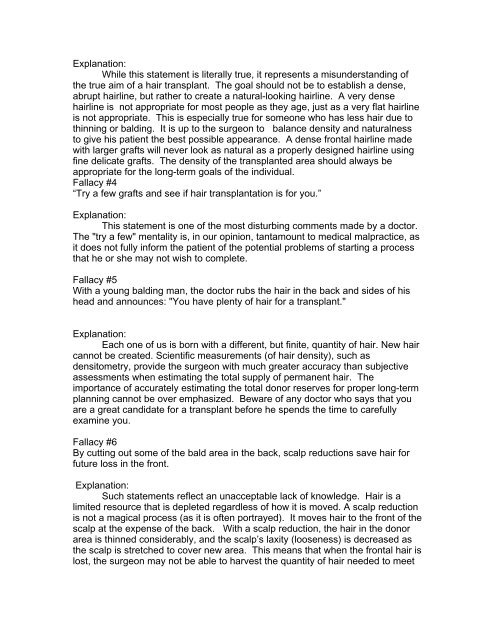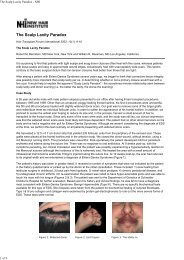The Patient's Guide to Hair Restoration - New Hair Institute
The Patient's Guide to Hair Restoration - New Hair Institute
The Patient's Guide to Hair Restoration - New Hair Institute
Create successful ePaper yourself
Turn your PDF publications into a flip-book with our unique Google optimized e-Paper software.
Explanation:<br />
While this statement is literally true, it represents a misunderstanding of<br />
the true aim of a hair transplant. <strong>The</strong> goal should not be <strong>to</strong> establish a dense,<br />
abrupt hairline, but rather <strong>to</strong> create a natural-looking hairline. A very dense<br />
hairline is not appropriate for most people as they age, just as a very flat hairline<br />
is not appropriate. This is especially true for someone who has less hair due <strong>to</strong><br />
thinning or balding. It is up <strong>to</strong> the surgeon <strong>to</strong> balance density and naturalness<br />
<strong>to</strong> give his patient the best possible appearance. A dense frontal hairline made<br />
with larger grafts will never look as natural as a properly designed hairline using<br />
fine delicate grafts. <strong>The</strong> density of the transplanted area should always be<br />
appropriate for the long-term goals of the individual.<br />
Fallacy #4<br />
“Try a few grafts and see if hair transplantation is for you.”<br />
Explanation:<br />
This statement is one of the most disturbing comments made by a doc<strong>to</strong>r.<br />
<strong>The</strong> "try a few" mentality is, in our opinion, tantamount <strong>to</strong> medical malpractice, as<br />
it does not fully inform the patient of the potential problems of starting a process<br />
that he or she may not wish <strong>to</strong> complete.<br />
Fallacy #5<br />
With a young balding man, the doc<strong>to</strong>r rubs the hair in the back and sides of his<br />
head and announces: "You have plenty of hair for a transplant."<br />
Explanation:<br />
Each one of us is born with a different, but finite, quantity of hair. <strong>New</strong> hair<br />
cannot be created. Scientific measurements (of hair density), such as<br />
densi<strong>to</strong>metry, provide the surgeon with much greater accuracy than subjective<br />
assessments when estimating the <strong>to</strong>tal supply of permanent hair. <strong>The</strong><br />
importance of accurately estimating the <strong>to</strong>tal donor reserves for proper long-term<br />
planning cannot be over emphasized. Beware of any doc<strong>to</strong>r who says that you<br />
are a great candidate for a transplant before he spends the time <strong>to</strong> carefully<br />
examine you.<br />
Fallacy #6<br />
By cutting out some of the bald area in the back, scalp reductions save hair for<br />
future loss in the front.<br />
Explanation:<br />
Such statements reflect an unacceptable lack of knowledge. <strong>Hair</strong> is a<br />
limited resource that is depleted regardless of how it is moved. A scalp reduction<br />
is not a magical process (as it is often portrayed). It moves hair <strong>to</strong> the front of the<br />
scalp at the expense of the back. With a scalp reduction, the hair in the donor<br />
area is thinned considerably, and the scalp’s laxity (looseness) is decreased as<br />
the scalp is stretched <strong>to</strong> cover new area. This means that when the frontal hair is<br />
lost, the surgeon may not be able <strong>to</strong> harvest the quantity of hair needed <strong>to</strong> meet



